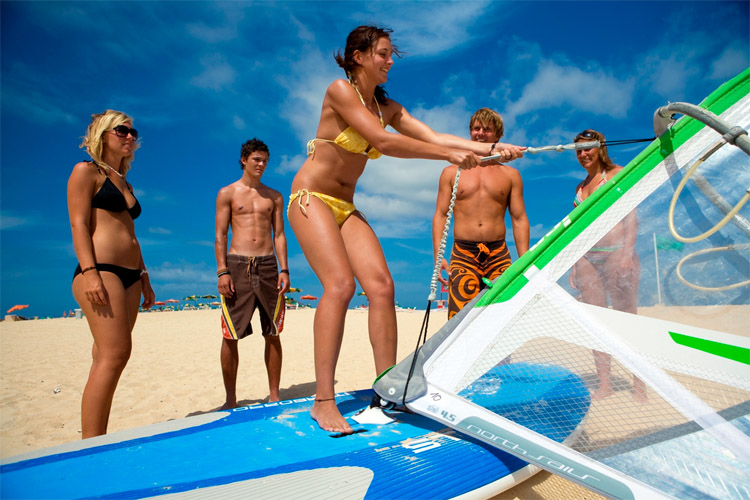Windsurfing land simulators allow beginners to understand the basic sailing positions and maneuvers, but they are also helpful in teaching first-timers the wind's behavior.
Windsurfing has its secrets. If you've never tried sailing, you won't be able to pick up a windsurfer and ride away instantly.
You've got to learn the fundamental principles of the wind, its forces, and how it interacts with a sail, a windsurf board, and human counterbalance.
Land simulators anticipate mistakes while avoiding potential injuries. That is why many windsurfing schools have built their own windsurfing simulators.
They work pretty well, even without wind.
These simple structures allow novices to get on the board, uphaul their rig, rehearse the basic position, turn the board, steer, stop, and control the sail in relation to the wind.
Building a windsurfing simulator can be easy.
If you want to step up the game, you can buy high-end aluminum and carbon materials. But for a simple model, you just need wood, straps, nuts, bolts, and screws.
In the end, the rig will behave as if you were in the water. It will move around its axis in all directions and can be used on the beach or in any indoor area.
Materials
Take a look at the materials and equipment you'll need to build your first homemade windsurfing simulator:
- Old freeride windsurf board;
- Small sail;
- Boom;
- Piano dolly;
- 1.5-inch floor flange;
- Angle iron frame;
- Two strong straps;
- 4' x 3' wooden plank;
- Toilet flange with a 1.5-inch reducer;
- Nipple;
- Four flat bolts;
- Two thick polystyrene planks;
Building a Windsurfing Simulator 101
Now, let's start building the windsurfing simulator:
- Remove any centerboard or fin from the board;
- Measure the width and length of the piano dolly;
- Cut the thick polystyrene planks and the angle iron frame with the same width as the piano dolly;
- On the bottom of the board, mark the center of the piano dolly one foot behind the mast base - this will be the rotation point;
- On the bottom of the board, place the polystyrene planks on the top and bottom ends of the piano dolly;
- Place the angle iron frame halfway between the polystyrene planks;
- Place the piano dolly over the polystyrene planks and the angle iron frame;
- Use screws to attach the piano dolly to the angle iron frame;
- Use screws to attach the floor flange to the angle iron frame;
- Strap the piano dolly to the board;
Now, we only need to finish the platform before stepping on our new windsurfing simulator;
- Center the toilet flange upside down on the wooden plank;
- Use screws to attach the toilet flange to the wooden plank;
- Insert the nipple in the toilet flange;
- Connect the platform to the windsurf board;
Enjoy your new homemade windsurfing simulator, and please remember to always wear a helmet.
